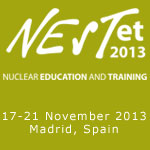
Issue No. 40 Spring
|
ENS News |
ENS Events |
Member Societies |
YGN Report |
PIME 2013: Communicating Nuclear A Young Generation report on the ETRAP 2013 conferenceInterview with Philippe Samama |
Corporate Members |
ENUSA TECHNOLOGY FOR THE CHINESE NUCLEAR MARKET L-3 MAPPS Full Scope Simulator for Embalse Is Ready for Training |
ENS World News |
ENS Members |
Links to ENS
Member Societies |
 |
NESTet 2013 |
| ____________________ |
ENS NEWS N° 40: IntroIn November 2012, as I’m sure many of you are well aware, the European Commission (EC) presented a package of measures to boost research, innovation and competitiveness in Europe. It is called Horizon 2020 and proposes an €80 billion investment programme to cover the period from 2014 to 2020. Under the package the Euratom Programme, which covers the period 2014-2018, should receive €1.79 billion. This will be allocated to fission research, fusion research, and research programmes run by the EC’s Joint Research Centre (JRC). This flagship initiative supports the fundamental principle that research and innovation are crucial to the creation of jobs and growth in Europe. In addition, it aims to strengthen the EU’s industrial leadership when it comes to innovation. According to the EC, Horizon 2020 should also “provide a major simplification through a single set of rules and will combine all research and innovation funding currently provided through the Framework Programmes for Research and Technical Development, the innovation related activities of the Competitiveness and Innovation Framework Programme (CIP) and the European Institute of Innovation and Technology (EIT).” Naturally, the life-blood funding that the nuclear research community receives largely determines the current course and future direction of nuclear research in Europe. Whether or not the politics of funding, or indeed politics in general, is your cup of tea, politicians and decision-makers inevitably influence how you ultimately do your job – whether you like it or not. They fashion your working environment, establish your priorities and can increase or decrease the chance that your innovative, groundbreaking work will bring successful solutions to the marketplace. Indifference to or disdain of what some call the “Machiavellian arts” might be an understandable reaction but is perhaps not the best policy to pursue. But how does Horizon 2020 stand up to closer scrutiny and what has been - and should be - the reaction to it from the wider nuclear community? In September 2012, FORATOM produced an official position paper summarizing the European nuclear industry’s response to Horizon 2020 and providing recommendations as to how it should be improved. While the European industry strongly supports the continuing emphasis on the public funding of nuclear fission research at EU level, and welcomes the overall increase in funding for Framework Programme Seven (FP7) activities provided under Horizon 2020 (€80 billion compared to €53 billion for FP7 activities), it has expressed its disappointment that the proposed funding for fission activities (€355 million as compared to €287 million previously) has not been increased in the same proportion. Although the industry recognizes that safety research should be an important element of the programme, especially after Fukushima, it criticised what it sees as the “almost total dedication of the programme’s scope to safety”, which tends to undermine other important research objectives such as reactor life extension, new reactor designs and the promotion of the European Sustainable Nuclear Industrial Initiative (ESNII) that was launched back in 2010 under the Strategic Energy Technology Plan (SET-Plan). But what do researchers in the field think? What should the priority areas be? Is the amount set aside for fusion research disproportionately large compared to that for fission? And if so why? What short and long-term effect will inadequate funding in the areas that matter most have on the ability of the research community to deliver? How will such a funding imbalance influence or undermine the overriding aim of Horizon 2020, namely to boost Europe’s growth and competitiveness and to sustain its position as a global research and innovation leader? What more should the nuclear community do to persuade the powers that be to focus on those research areas where an increase in funding is most needed? The answers to these questions may seem pretty obvious, but are politicians and the wider public fully aware of what is at stake? It is in the interest of the whole nuclear research community that they be made aware. As is often the case, there are probably more questions than answers. ENS NEWS would like to receive and publish the opinions of its readers on the fundamental questions that initiatives like Horizon 2020 raise. It is the views of frontline researchers that should most be heard and listened to.
|
||
|
||
Is there still a Fukushima impact on university enrollment?Nuclear education has seen many ups and down since the birth of nuclear technology. Nuclear education, along with nuclear technology, witnessed its peak during 1960s due to the very high support it received from all stakeholders. |
